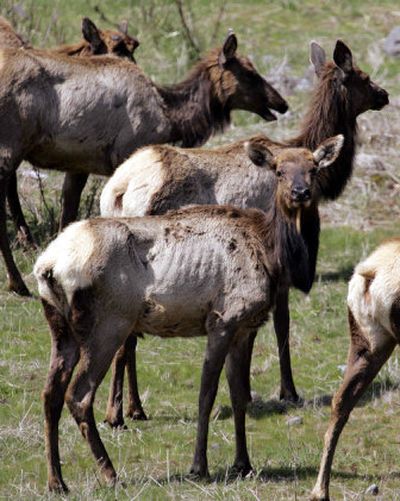Mount St. Helens elk starving to death

MOUNT ST. HELENS WILDLIFE AREA, Wash. – More than 25 years after its eruption turned this river valley into moonscape, elk living in the shadow of Mount St. Helens are starving to death at a rate that has alarmed many observers.
This winter’s elk die-off was the highest recorded by state wildlife managers in seven years, and some critics say the survivors are so undernourished and the forage so poor that another major winter kill could be on the way.
State officials have responded by bumping up the number of hunting permits and pledging to speed up their sweeping management plan for the thousands of elk here.
But the herd management plan has languished for five years already, and skeptics say the government appears unconcerned with helping elk survive the coming winter.
“The elk didn’t ask for us to plant 10 years of grass seed in that area in there and create false forage. They didn’t ask not to be hunted for 20 years,” says Mark Smith, a local businessman and head of the Mount St. Helens Preservation Society. “If these were horses these people would be in jail.”
The Mount St. Helens area is home to more than 13,000 elk. They range together in various subgroups, tied mostly by shared geography in what Washington state wildlife officials consider the state’s largest herd.
Wintertime deaths from starvation are a regular phenomenon. State wildlife managers say up to 10 percent of a herd can be expected to die in a typical winter, with mortality figures higher in harsher conditions.
Officials can get a feel for broader winter death totals by counting elk in the Mount St. Helens State Wildlife Area, an open area of volcanic mudflow that hugs the north fork of the Toutle River west of the volcano.
Elk can be seen here most of the year, but the population is more concentrated in the winter when snow pushes animals out of the higher elevations.
This year, the state counted about 630 elk wintering in the wildlife area and 63 likely starvation deaths at the end of the season.
That’s the highest recorded figure since the winter of 1999, when about 80 elk died. But it’s still within the 10 percent death figure considered typical, said Brian Calkins, the state’s regional wildlife manager.
“I don’t think our population has increased a whole lot since 1999. I think the weather probably plays a lot more into it than anything else,” he said.
State officials also point out that the Mount St. Helens area offers unique challenges for elk forage.
The land here was suffocated by the mountain’s 1980 eruption, and hunting was curtailed after the blast.
The area is now healing, and the underbrush that elk prefer is now being overtaken by increasingly larger evergreen trees in the replanted forest land.
The state wildlife area is managed to remain open and brushy, which is why elk congregate there in the winter. But the soil, capped by mud and ash from the eruption, is relatively poor.
“It’s right in the core of where the impact was, and where the elk ended up needing that area for critical winter habitat,” said Dave Brittell, the state assistant director for wildlife programs.
Others disagree with the state’s winter kill figures and say elk deaths also were pushed into higher elevations this year because fluctuating winter weather caused elk to move up and down the terrain.
The alarm over elk deaths was amplified this spring when residents of southwestern Washington saw a privately filmed video on the local television news showing dead and dying elk around Mount St. Helens.
Some elk in the video were so weak that they lay on their sides and pawed at the ground in unsuccessful attempts to stand up.
State Rep. Ed Orcutt, R-Kalama, took a trip to the wildlife area after seeing the video and said he found animals in similar conditions.
“I think what’s happening is that Fish and Wildlife has just failed to adjust the herd population to take into consideration what’s happening with habitat up there,” said Orcutt, a forester by trade.
Orcutt subsequently called for the firing of state Fish and Wildlife Director Jeff Koenings, a suggestion that was denounced by the agency head and the state Fish and Wildlife Commission.
Foresters for Weyerhaeuser, which owns vast tracts of timber land around the volcano, have been troubled by what they see as too many elk, company spokeswoman Jackie Lang said.
Aside from encounters with starving animals, company foresters must contend with elk eating the tender tops of young trees, which interferes with crucial periods of tree growth.
“The problem is, we’ve got too many elk and not enough forage. So what’s the solution? Either provide more forage or reduce the elk population,” Lang said.
The commission did approve 30 additional elk permits in areas around the blast zone; hunting on the wildlife area itself is still limited to 10 permits issued to disabled hunters.
Orcutt and other critics say that’s not enough to ensure the elk herd will be small enough to get enough food from the mudflow zone next winter.
“It’s more noticeable now because the elk are continuing to get in poorer and poorer shape,” said Smith, the Preservation Society president. “The focus has to be taken off the dying ones – they’re dead and gone.”